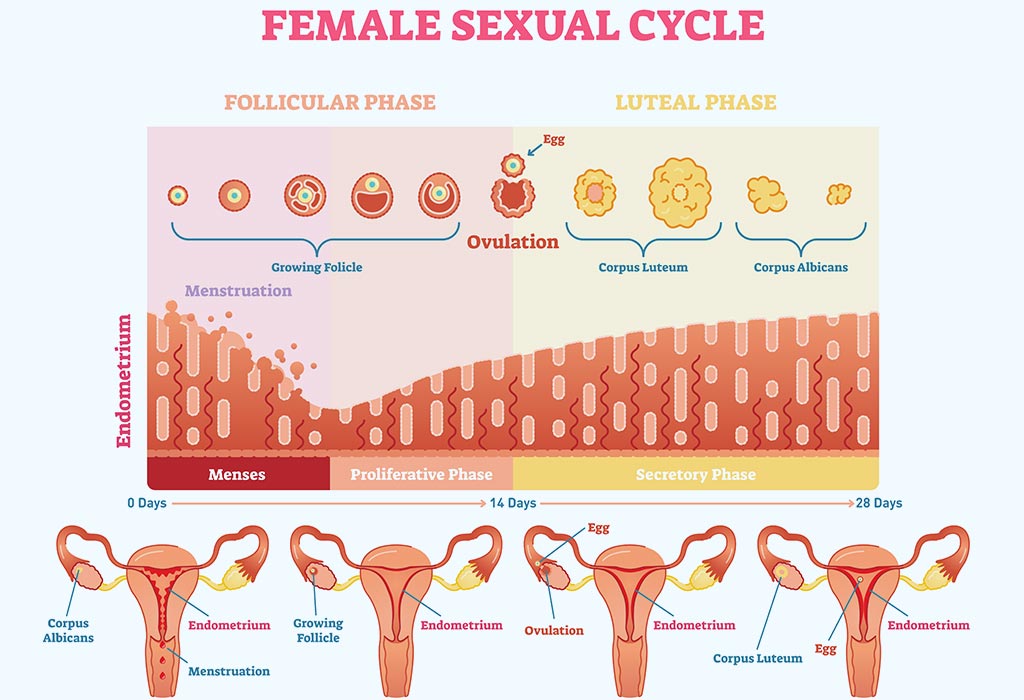In this Article
For a body to sustain pregnancy, a number of things need to fall into place for conception to be successful. Fertilization is just the tip of the iceberg – there are a ton of processes that take place in your uterus that ensure the egg stays secure. One of the key aspects in that regard is the endometrium and the thickness of its wall.
What Is an Endometrium?
The uterus has a lining made of mucous membranes on the inner side of its wall. These, altogether, constitute the endometrium. There are two layers that build it up – one is the functional layer that sheds itself during each menstrual cycle, and the other layer is the base that remains on the wall of the uterus permanently. Depending on the menstrual cycle, the thickness of the endometrium keeps changing.
What Is the Normal Endometrial Thickness for Pregnancy to Occur?

The endometrial layer in itself pretty thin. Towards the end of the menstrual cycle, when the upper layer has shed completely, the layer that remains is barely about 1 mm thich. As the next ovulation cycle begins, the cells start creating the new functional layer above it.
The thickness of the layer usually varies from person to person, but the normal range of endometrial thickness for conceiving is considered to be around 8 mm which needs to go up to around 15 mm to be able to hold the fertilized egg securely.
What Causes a Thin Endometrium?

A thin endometrium may be caused due to several reasons.
1. Poor blood flow
If the uterus does not receive adequate supply of blood, it may have trouble creating an endometrium that is thick enough for conception. The lack of adequate blood flow may be due to a tilted uterus, uterine fibroids or even a sedentary lifestyle.
2. The Wrong Pace of Endometrium Growth
On a general basis, it has been observed that any thickness less than 6mm can prevent conception from being successful. However, even at 8mm thickness, if the growth of the endometrial layer is not at the pace as it should be, it could inhibit conception.
3. Estrogen-related Issues
Reduced levels of estrogen could sometimes prevent the growth of cells, which in turn inhibits the thickening of the endometrium.
4. Improper Functioning of Progesterone
When the progesterone hormone does not function in the manner it needs to, the endometrial layer does not thicken.
5. Side-effects of Fertility Drugs
In a cruel twist of irony, certain drugs that are used to boost fertility and trigger ovulation might inadvertently cause a side-effect that results in the thinning of the endometrial layer.
6. Stressful Lifestyle
The absence of enough rest and sleep could result in stress, which can prevent the optimal growth of the endometrium.
Ways to Increase Endometrial Thickness for Conceiving
There are a few ways in which you can improve the thickness of your endometrial layer and make it apt for conception. Here they are:
1. A Good Diet

Consuming a diet that is balanced and nutritious affects the levels of estrogen, maintains a balance of hormones, and boosts blood flow. All of these factors together assist in the growth of the ideal endometrial thickness for pregnancy.
Consume meals throughout the day to keep your levels of insulin and cortisol at a healthy level. Include fibre in the diet as well as food items that have the Q10 coenzyme. This is a powerful antioxidant that reduces tissue-related stress and helps cultivate a thick endometrial layer.
Items like green leafy vegetables, tomatoes, eggs, carrots, and fish contain important vitamins like vitamin C and vitamin E along with the B-complex groups which are necessary for healthy blood circulation, so make sure to add these items in your diet. Cut down on sour food items and caffeine to improve your health.
2. Enough Rest
Good amounts of rest and sleep help bring a good balance of hormones which affect the thickening of the endometrium. An uninterrupted sleep of at least 7-8 hours is essential for the body to conduct its repair activities and undertake tissue growth optimally. Maintain a schedule of waking up and sleeping on time on a daily basis, and avoid staying up for long hours or late at night.
3. Regular Exercise
A natural way to boost blood circulation is exercise. The increased supply of blood to the uterus also assists in the growth of the endometrium cells, increasing thickness.
Intensive exercises aren’t necessary; spending about half an hour every day should suffice. Do varied forms of exercise to prevent your body from getting accustomed to one form of activity. Exercise helps induce good sleep, thus assisting in the growth of the endometrial layer.
4. Massaging the Femoral Artery
A proven way to boost the supply of blood towards the uterus and the pelvic region of the body is stimulating the femoral artery. Using your fingers, gently apply pressure on the artery for a few seconds. Repeat this exercise three times on each leg a couple times a day. This should usually be done following the end of the menstrual cycle until ovulation occurs so it can properly assist in the growth of the endometrium. In cases of IVF or high blood pressure symptoms, massaging the artery should be avoided.
Here is how to perform the femoral artery massage:
- Find the crease between your upper thigh and abdomen.
- Going along the crease, find the pulse. Press on it gently till you feel the pulse stop.
- Hold it for 30 seconds. Once the time is up, release the pressure.
- Repeat this process on the other leg. Then, gently massage your belly to allow the blood to circulate in the ovaries and uterus.
You are advised not to perform this exercise if you’re certain you are about to start your period or are pregnant.
5. Acupuncture
Acupuncture helps in restructuring the blood supply within the body, providing a boost to fertility. This ancient practice is also known to streamline delivery and provide relief to pregnant women. Studies have shown that reinforcing blood circulation around the kidneys can promote the formation of uterine endometrial blood vessels, which in turn can make the IVF process successful.
6. Castor Oil
Ricinoleic acid is a chemical that is known to increase the flow of blood, boost healing, and help in the formation of tissues. This particularly affects the ovaries and the womb. This acid is found in castor oil, and making use of it can be quite beneficial.
Here is a castor oil pack you can use to help increase blood flow and thicken your endometrial layer:
- In an empty bowl, take a soft cotton cloth or handkerchief.
- Pour castor oil on it – put enough that the handkerchief is covered with oil. Keep tossing the handkerchief in the bowl so that it absorbs all of the castor oil.
- Leave this handkerchief in the bowl for around 30 minutes.
- When the handkerchief has soaked all of the castor oil, lie down on your back and put the cloth on your bare stomach. The cloth should cover the area starting from your navel, all the way down to your hip bones.
- Once you have placed the handkerchief, put a plastic cover or wrap on it. Take a hot water bottle and place it on top of the plastic wrap, on your stomach. Lay down in this position for 30-40 minutes.
- Continue this activity regularly, but do not do it when you are menstruating.
FAQs
1. How Much Endometrial Thickness Is Too Much?

Just as a thin endometrial layer is a problem, an endometrial layer that is too thick can also be an issue. Endometrial hyperplasia is the medical term to define this condition, which usually occurs due to excessive estrogen levels. This is where the layer gets thicker than even 10-15 mm.
2. Is It Possible to Get Pregnant With an Endometrial Thickness of 5 mm?
5 mm is too thin a layer to sustain a pregnancy. Ovulation induction and progesterone supplements might be required.
The right endometrial thickness for conception is an essential component in the entire process of getting and staying pregnant. Adhering to healthy lifestyle choices and adopting proper treatment procedures to take care of the condition can help your body become a great environment for a baby.






